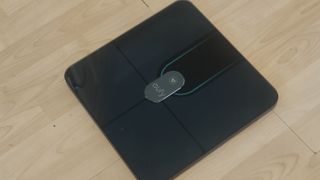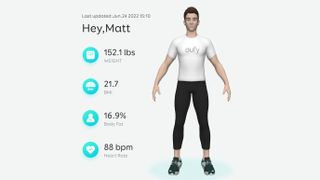How to use a smart scale
Calculate your weight, BMI, body fat percentage and more

Smart scales are a useful tool in your fitness arsenal. They go far beyond your old-fashioned analog scale, providing a standard measurement of weight: these scales interface with your measurements on corresponding apps to offer your body mass index, percentage of fat, percentage of muscle and many more useful health metrics.
The best smart scales do this fast and accurately, often interfacing with activity metrics from your fitness tracker or smart watch, especially if you find one that interfaces with the same fitness ecosystem as your wrist-mounted device, such as the Garmin Index S2 or Fitbit Aria Air.
However, smart scales can do so much for you, that it’s important to know how to get the best out of them.
Setting up your smart scale
Unlike a normal scale, which just requires you to unbox it and away you go, smart scales demand a little bit more administration at first. Like other electric scales, they tend to run on either replaceable batteries or lithium rechargeable ones, like many other smart devices.
Once the device is powered up, you’ll need to run through two extra steps: connecting the smart scale to your phone via Bluetooth, and downloading the corresponding app.
The app itself will differ from device to device, but most apps, like the EufyLife app pictured which matches the Eufy P2 Pro, will at least require you to input your gender, age, and height so that your regularly updating weight can be taken into a slightly wider context.
Most will be able to use this new information to calculate your BMI, which is a population-level aggregator and estimation of a healthy weight. However, some of the best smart scales do more: to set up the Eufy, for example, you can also input measurements of your chest, biceps, waist, hips and thighs, in order to create a virtual model of yourself in the accompanying app.
Get daily insight, inspiration and deals in your inbox
Get the hottest deals available in your inbox plus news, reviews, opinion, analysis and more from the TechRadar team.
This will allow the scale to more accurately calculate your fitness metrics, including your body composition. The best smart scales tell you your muscle, fat and bone percentages, illustrating whether they’re in or outside a healthy range for your age, height, weight and gender.

Using your smart scale
On the surface, it’s as simple as using a normal scale: step on, and the scale will list off your weight in your chosen denomination (pounds or kilograms) in addition to other statistics on the on-device digital display.
However, the next step is to check your app, which should automatically update with your latest stats. Of course, your updated weight will then impact all the corresponding statistics such as BMI and body composition, depending on what particular statistics your chosen fitness tracker chooses.
If you’re using a scale linked to your tracker, such as Fitbit Aria or Garmin Index S2, your Fitbit Premium or Garmin Connect account will update automatically with your new statistics. This means your weight, muscle and fat percentages, sleep, activity metrics and more are all in one place – it’s a great way to create a central hub for all your health data.
Use your smart scale responsibly
Weight, fat, and activity research, when taken too far, can be a minefield to navigate with our mental health intact. Because of this, it’s probably wise to use your smart scale as a regular check-in to ensure your health metrics are accurate, as it’s easy to become too obsessed with pounds and percentages. We've covered a little bit of this anxiety when talking about Strava and publishing your exercise statistics for everyone to see, but it can equally apply to the pressure you put on yourself.
Research from the University of Minnesota found that when it comes to self-weighing, “with regard to affect, self-esteem and body evaluation, and eating-related behaviors and cognitions, in total, most studies provided evidence of a harmful impact of self-weighing on these outcomes; fewer studies found a positive impact.”
Numbers on the scale aren’t all that matters unless you’re an elite athlete. If you’re a casual fitness enthusiast and you’re eating healthily, drinking water and enjoying exercise on a regular basis, don’t be disheartened if the scale doesn’t show the result you wanted.

Matt is TechRadar's expert on all things fitness, wellness and wearable tech. A former staffer at Men's Health, he holds a Master's Degree in journalism from Cardiff and has written for brands like Runner's World, Women's Health, Men's Fitness, LiveScience and Fit&Well on everything fitness tech, exercise, nutrition and mental wellbeing.
Matt's a keen runner, ex-kickboxer, not averse to the odd yoga flow, and insists everyone should stretch every morning. When he’s not training or writing about health and fitness, he can be found reading doorstop-thick fantasy books with lots of fictional maps in them.
